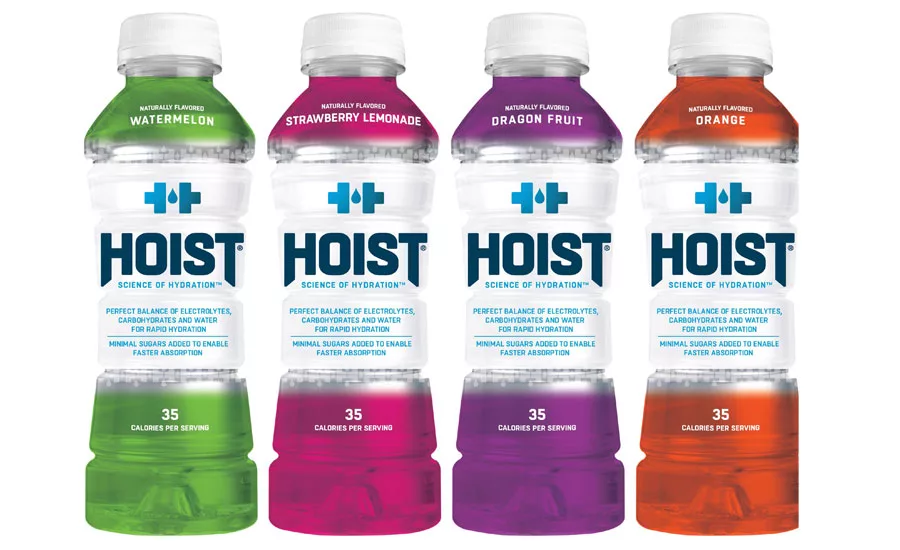Shrink, stretch labels revolutionize beverage packaging
Suppliers address sustainability through downgauging

Today’s consumers are blessed with an ever-growing choice of beverage solutions. As these beverage options proliferate, so do the packaging options. Among the options, shrink and stretch labeling materials are “stretching” the creativity brand owners can utilize for packaging.
“Shrink sleeves in the beverage market continue to be a strong packaging solution for our customers,” says Kimberly Flynn, marketing manager for Hammer Packaging, Henrietta, N.Y. “The beverage market in particular is extremely competitive, so to draw consumers to your product on a crowded shelf, you really rely heavily on the stopping power of your package decoration. The introduction of shrink sleeves with a 360-degree canvas revolutionized the way packages are designed and we’ve only seen that trend continue to grow and evolve over time.”
Gwen Chapdelaine, marketing director for Elk Grove, Ill.-based Fort Dearborn Co., highlights that the visual and branding appeal that shrink and stretch sleeves provide have helped the labeling materials become one of the fastest growing in the label market. Within beverage, Chapdelaine says one of the key contributors to shrink- and stretch-sleeve utilization is the growing number of new products entering the market.
“Shrink and stretch sleeves help beverages differentiate themselves on shelf by combining shape and color for 360-degree, eye-catching beverage packages,” she says. “This combination creates product distinction and visual appeal not achievable with other label formats. The sleeves can also incorporate tamper evidence for product safety.
“Consumers are increasingly demanding transparency from the products they purchase,” Chapdelaine continues. “Shrink and stretch sleeves can provide the consumer with transparency by using clear windows on portions of the label so that consumers can view the contents of the product in a clear container.”
Making the investment
When deciding the type of labeling materials in which to use, beverage-makers are tasked with considering a number of factors. Although shrink and stretch sleeves might come with a higher price tag, suppliers note that the benefits make it worth the investment.
“Shrink sleeves are about 25 percent more expensive than pressure-sensitive labels generally speaking, says Mark Hill, vice president and assistant director of research and development (R&D) for INX International Ink Co, Schaumburg, Ill. “Sleeves can offer nearly 150 percent more real estate for brands to tell their story or communicate regulatory information. Pressure-sensitive labels are usually easier to render and the application is simpler compared to shrink sleeve. Film used for pressure-sensitive labels are typically polypropylene and are a relatively lower cost than PETG used in shrink sleeves.
“Product run size may dictate the printing method more so than whether it’s pressure-sensitive or shrink,” he continues. “We see shrink sleeves printed digitally, offset, flexographic and gravure, and cost increases in that order. I feel people view products in shrink sleeve as more desirable or valued higher than a competing product in a common label.”
Neal Konstantin, president of PDC International, Norwalk, Conn., also highlights the value that beverage-makers can attain when using shrink sleeves. “Shrink labels have the best return on investment in terms of brand impact by cost,” he says. “The total package coverage and form-fitting graphics are second to none.”
Beyond value, Justin Slarks, director of marketing for Little Rock, Ark.-based Sleeve Seal, adds that stretch and shrink sleeves hold up across a rugged distribution process while offering a premium look.
“Cost per impression, durability of the labels, recyclability and the ability to incorporate a tamper evident seal are all factors but the graphic possibilities are really what is the most appealing to manufacturers,” he says. “We are seeing some great looking labels in the market that are an extension of what designers are looking for in the ‘look’ of the product.”
Embracing the movement
For the beverage market, nearly all categories are seeing brands that utilize shrink or stretch labels; however, suppliers note that some markets are more likely than others.
“We see a growing trend with performance and fitness beverages (protein shakes, etc.), as this market is becoming increasingly competitive,” Hammer’s Flynn says. “We’ve also seen an increase in shrink sleeves for aluminum cans — beer, sparkling beverages, etc. It’s a great look, especially when you can incorporate the metallic shine of the can itself with various coatings and varnishes to give it that extra pop.”
Fort Dearborn’s Chapdelaine highlights the alcohol categories that have embraced the labeling material trend. “We’ve also seen more spirits products are being introduced in sleeves and more can beverages are now utilizing sleeves,” she says. “In the craft beer market as well as other beverage segments, shrink sleeves are being used as an economical alternative to pre-printed cans. The sleeves offer volume and versioning versatility.”
INX International’s Hill adds that he’s seen usage of shrink and stretch sleeves within dairy and non-dairy alternative drinks as well as juices. “There seems to be more use in the convenience sizes,” he says.
Beyond beverage categories, suppliers also are taking notice of the size of the companies and brands employing shrink and stretch labels.
“It is the perfect technology to infuse new life into an established brand, as well as the ideal platform for differentiating new products from ‘also-rans’ in the category,” PDC’s Konstantin says.
Sleeve Seal’s Slarks also notes that established and emerging brands are using shrink and stretch labels, but in different capacities. “Established brands are expanding the use of shrink labels in their facilities and buying new, faster applicators while the emerging brands are looking to co-packer’s equipment to apply shrink labels until they have their own production,” he says.
“The benefits of shrink labels continue to be of value to both established and emerging brands,” Slarks continues. “In fact, the established brands set the bar for good-looking products and I think that the emerging brands feel some sense of having to utilize shrink labels to keep up with the Jones’s.”
Although more brand owners in the beverage market are opting for shrink and stretch sleeves for their labeling needs, suppliers emphasize the importance of doing one’s due diligence when utilizing them.
“It is critical to get a clear understanding on the substrate on which the label is printed,” PDC’s Konstantin says. “Each film, and it can vary by vendor, has a unique ‘shrink curve,’ which must be maintained to get consistent results over time. Buying the same label ‘type’ from a different converter isn’t enough. The base film has specific properties that need to be understood and monitored.
“In regards to equipment, total cost of ownership, including cutting blade life, need to be taken into account,” he continues. “Certain machines can go months between blade changes, while others last only a few days.”
Hammer’s Flynn notes that beverage-makers must take into account application equipment, container shape and film type when opting for shrink or stretch-sleeve label materials.
“Having the right application equipment is essential to ensuring that shrink sleeves fit nicely on the container and that the graphics display as intended,” she explains. “Also, understanding your container shape and how the label will distort is essential in building the graphic. Hammer Packaging’s pre-press team works one-on-one with our customers to help build the files and distort the graphics so they reproduce with precision.
“Lastly, film selection to match the container is critical,” Flynn continues. “Hammer has a dedicated technical engineering group to help determine the best film solution. Our internal lab will confirm film selections and shrink recipes before testing at a customer site.”
Because of the extra steps involved with shrink- and stretch-sleeve labels, Fort Dearborn’s Chapdelaine encourages its customers to involve the label supplier at the onset when considering these materials.
“We encourage our customers to get us involved upfront on a project to ensure success,” she says. “With shrink sleeves especially, it’s critical to choose the right material for the container and to take this into consideration during the container selection process. Shrink-sleeve labels also often need to include distortion of the graphics in order for the printed product to appear correctly once shrunk onto the container.
“Proper container sizing and line trials provide an opportunity to test for distortion,” Chapdelaine continues. “We recommend involvement with all key suppliers during the process: prepress, container, converter and application provider to eliminate unnecessary errors and waste upfront before full production. Our technical services group plays a critical role supporting customers with the application process and supplier partnerships.”
A green movement
The marketing value that shrink and stretch labels can provide has been recognized by many in the packaging industry. However, some have raised concerns about the environmental impact that the labeling materials could have compared with other options. To address these concerns, suppliers are searching for the right sustainability solution.
“Sustainability is a driving force in the development of new material types and gauges,” PDC’s Konstantin says. “Shrink tunnels need to be precise enough to compensate for lightweight, empty containers that can deform if excessive heat is applied. Stretch labels have the added benefit of not requiring heat at all.”
Hammer’s Flynn details the efforts that the label supplier is doing to address sustainability for its customers.
“We’re seeing more options for recyclability emerging from our suppliers, like de-seaming solutions, floatable films and recyclable films,” she says. “Hammer Packaging is committed to finding and improving sustainable shrink sleeve solutions that reduce packaging’s carbon footprint without compromising quality and the functional integrity of the label. Working closely with our film suppliers, we’ve made some great progress in this area and look forward to the future of sustainable packaging.”
Fort Dearborn’s Chapdelaine expects that sustainability will be part the future for shrink and stretch sleeves as suppliers continue to downgauge materials and interest in eco-friendly materials continues to grow. “Fort Dearborn offers thin gauge film label options as well as floatable films that meet APR recyclable guidelines for PET containers,” she says.
Sleeve Seal’s Slarks adds that downguaging will open up shrink and stretch sleeves to more beverage-makers. “Lightweighting is a trend furthering the cost per impression benefits of shrink labels and will continue to expand in the market as other labeler manufacturers develop technologies to apply thin films at speed,” he says. “Also, we are just now seeing ‘textural’ inks that not only have a unique look, but a unique ‘feel’ to the touch that adds to the customer experience with the product.”
No matter what the draw is, many suppliers are in agreement that the future looks bright for the shrink- and stretch-sleeve label market.
“I think we will continue to see growth,” INX International’s Hill says. “Smaller brand products are seeing some advantages of printing capabilities compared to other types of labels because of the premium graphics and 360-degree coverage. I think we will see more of our customer base get involved in the market in the coming years because it is easy to tailor brands based on region, culture, unique geographic flavors and container shapes and sizes. We will see this market grow.” BI
Looking for a reprint of this article?
From high-res PDFs to custom plaques, order your copy today!







